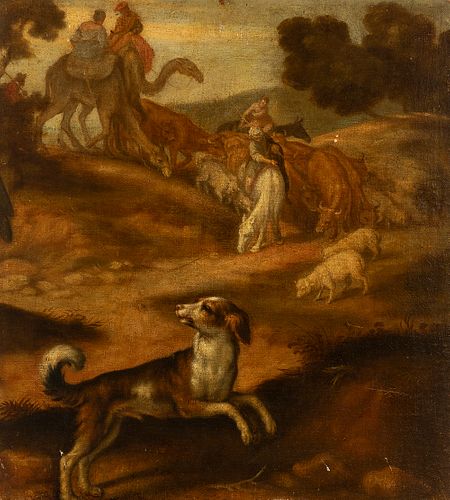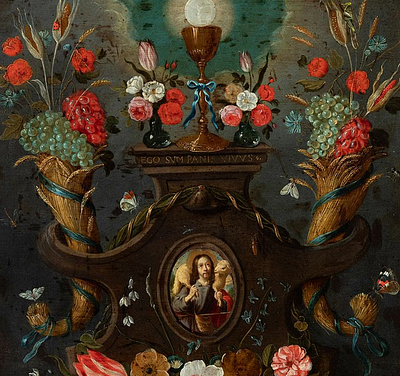PEDRO DE ORRENTE, (Murcia, 1580 - Valencia, 1645). "Scene from the Old Testament". Oil on canvas. Relining. It presents restorations.
Lot 44
About Seller
Setdart Auction House
Carrer Aragó 346
Barcelona
Spain
Setdart Subastas was born in 2004 and is currently the first online art auction in Spain with solidity, prestige and reliability guaranteed by our more than 60,000 users. Setdart has a young, dynamic and enterprising team ready to successfully manage the purchase and sale of art works through custom...Read more
Estimate:
EUR€1,600 - EUR€1,800
$1,684.21 - $1,894.74
Absentee vs Live bid
Two ways to bid:
- Leave a max absentee bid and the platform will bid on your behalf up to your maximum bid during the live auction.
- Bid live during the auction and your bids will be submitted real-time to the auctioneer.
Bid Increments
| Price | Bid Increment |
|---|---|
| EUR€0 | EUR€10 |
| EUR€200 | EUR€25 |
| EUR€500 | EUR€50 |
| EUR€1,000 | EUR€100 |
| EUR€3,000 | EUR€200 |
| EUR€5,000 | EUR€500 |
| EUR€10,000 | EUR€1,000 |
| EUR€20,000 | EUR€2,000 |
| EUR€50,000 | EUR€5,000 |
About Auction
By Setdart Auction House
Sep 21, 2021
Set Reminder
2021-09-21 10:00:00
2021-09-21 10:00:00
America/New_York
Bidsquare
Bidsquare : 21st September - ARAS JÁUREGUI Private Collection - Old Masters, 19th & 20th Century
https://www.bidsquare.com/auctions/setdart-auction-house/21st-september---aras-j-uregui-private-collection---old-masters-19th-20th-century-7429
Setdart Auction House sofia@setdart.com
Setdart Auction House sofia@setdart.com
- Lot Description
PEDRO DE ORRENTE, (Murcia, 1580 - Valencia, 1645). "Scene from the Old Testament". Oil on canvas. Relining. It presents restorations. Measurements: 64,5 x 58 cm. Immersed in an apparently desert landscape, several characters are inscribed. Arranged in such a way that they follow a completely baroque composition, like a zigzag, a characteristic that gives a great movement and depth to the scene. The image, in which animals and people merge, is presented in a pleasant manner, close to genre paintings in which the characters are defined by a multitude of activities. However, the clothing and even the presence of the camels invite the viewer to think of a biblical scene. In fact, both the dynamism of the composition and the thematic conception of the scene suggest that it can be related to biblical paintings by Pedro de Orrente, specifically Laban Seeks Idols, which is in the Museo del Prado collection. The museum scene features a large procession, populated by characters and camels, as in this case. The story tells the biblical tale of Laban catching up with Jacob's family. With the intention of searching for and recovering the idols that Rachel, Jacob's wife, had stolen. Known as "the Spanish Bassano", Pedro Orrente was a highly successful artist of his time, admired as a follower of the formulas of the famous Venetian family of artists, especially in his series of Old Testament themes set in lush landscapes. He lived in several Spanish cities, moving from his native Murcia to Toledo at a very young age, where he was already in 1600. If the fame of the Bassano family's works was enormous throughout Spain, the climate in the Castilian city must have been particularly receptive to their painting, as the works of the best masters who worked there attest. It is therefore not surprising that Orrente, who shortly afterwards travelled to Italy, went to Venice, where we find him as early as 1605. It is quite reasonable to think that he passed through the workshop of Leandro Bassano, whom Jusepe Martínez classified as his master. In 1607 he was already back in Spain, settled in Murcia. He continued to visit other Spanish cities, especially Toledo and Valencia, although he must also have spent time in Madrid. During his stay in Venice he must not only have learnt Bassano's pictorial manner, but also took on board his conception of painting as a market-oriented activity. His treatment of sacred themes as genre scenes would be fundamental in this respect. These were, above all, lively series of biblical stories with which fans could be flattered by the variety and dynamism of the works, populated by a large number of characters set in landscapes and accompanied by all kinds of animals and everyday objects. Works by Pedro Orrente are currently held in the Prado Museum, the Hermitage in St Petersburg, the Kunsthistorisches Museum in Vienna, the Metropolitan Museum in New York, the Fine Arts Museums of Bilbao and Valencia, and the National Gallery of Denmark, among many others.
- Shipping Info
-
In-house shipping available. Please inquire at admin@setdart.com.
-
- Buyer's Premium



 EUR
EUR CAD
CAD AUD
AUD GBP
GBP MXN
MXN HKD
HKD CNY
CNY MYR
MYR SEK
SEK SGD
SGD CHF
CHF THB
THB














